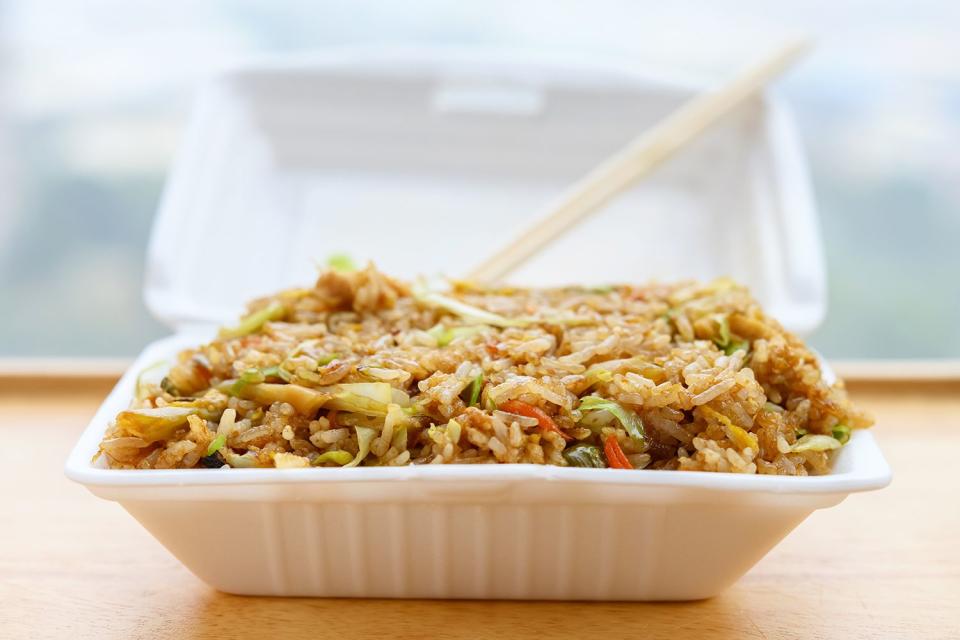What Is ‘Fried Rice Syndrome’? A Food Safety Expert Weighs in on the Dangers of Eating Leftover Starchy Foods
A 2008 report of a man who died after eating room temperature spaghetti has resurfaced and gone viral, prompting concerns over consuming leftovers. Here's what you need to know

Getty
HealthTok is warning TikTok users with some unsettling yet crucial information about properly cooking and storing food.
A series of videos have gone viral on the social media platform, referring to a 2008 report of a 20-year-old man who died after eating room temperature spaghetti that was contaminated with bacillus cereus. The case report, which was documented in the National Library of Medicine, explains that within 30 minutes of consumption, the man experienced a wide range of symptoms, such as headache, abdominal pain, and nausea, and diarrhea. He died in his sleep that night.
A similar case occurred in March 2021, when a man from England suffered the same symptoms after consuming leftover lo mein noodles. He ultimately lived, but required multiple amputations.

Getty
Related: General Mills Recalls 4 All Purpose Flour Varieties Due to Possible Salmonella Contamination
TikTok users have coined the term "fried rice syndrome" for the bacterial infection. But what causes the illness and how can it be prevented?
Lawrence Goodridge, professor of Food Safety at University of Guelph, tells PEOPLE that baccilus cereus can be found in a wide range of starchy foods such as pasta, whole wheat, and more. "Rice is always the big one," he says.
The bacteria forms as a spore during the cooking process — but it only grows when it's left at room temperature, he tells PEOPLE.
"When they grow in the food, they produce toxins, ones that can make us vomit or have diarrhea. If you eat that food, then you get sick," Goodridge explains.
He says that although it’s something to be wary of, near-death experiences and fatalities are quite uncommon. Goodridge says that for the most part, cases result in abdominal issues and headaches.
"Most people who eat the food within half an hour to five or six hours will get sick," he says. "That illness will last for about 24 hours. It's really only in a small percentage of cases that'll be more severe, where one can lead to people can have amputations or death, as in this case that's on TikTok."
It's even quite rare to get sick from this, especially when compared to other foodborne bacteria such as salmonella. In the U.S., he says there are about 63,000 cases a year, and in Canada, about 36,000 cases — which is relatively negligible, compared to other bacterial illnesses.
But, there are still measures home chefs can take to fend off bacteria — some include properly boiling rice (or other starch) to cook it, and keeping it out of what he calls "the danger zone."

"The danger zone is a temperature range between 40 degrees and 140 degrees Fahrenheit. That's the range in which this bacteria and other food borne bacteria grow the quickest," he explains. "There's a saying we have. Keep hot foods hot and cold foods cold. If the rice is not going to be consumed right away, you want to keep it higher than 140 degrees Fahrenheit, and if it's not going to be consumed for a while, then you want to cool it down to four degrees Celsius, 40 degrees Fahrenheit within three hours, two to three hours. Basically you do that by putting it in the fridge."
Goodridge adds that while storing something large like a pot of rice, the food should be divided into smaller portions. Because when the temperature lowers "through the danger zone," bacteria will grow in those cooling temperature ranges.
"If you just put the big pot into the fridge, then it will take a lot longer to cool. As the temperature comes down through the danger zone, it'll take a lot longer to cool and the bacteria can grow," he says.
He also recommends to only keep leftovers for up to four days, and to reheat to at least 165 degrees Fahrenheit to kill off any potentially harmful bacteria.
When it doubt, throw it out.
For more People news, make sure to sign up for our newsletter!
Read the original article on People.


